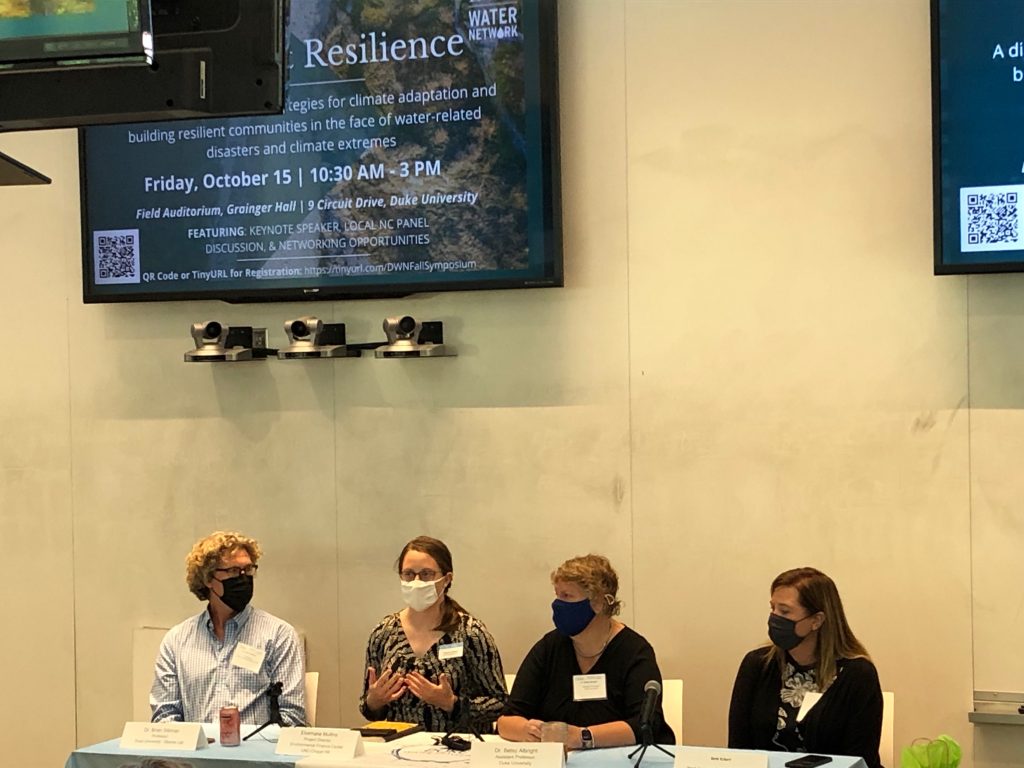
How can we build communities that are resilient to environmental disasters and other related challenges, and how can a multidisciplinary approach guide us through this process?
The Disaster and Resilience Water Symposium, hosted by Duke Water Network at the Nicholas School of the Environment in October, sought to answer these questions through a focus on water systems. It brought together a multidisciplinary panel of experts, including Elsemarie Mullins, Project Director at UNC EFC.
To start, what exactly is “resiliency?” According to keynote speaker Marlena Byrne, a resilient system, whether ecological or human, is not merely one that can weather a challenge and bounce back from it, but also one that can adapt to evolving challenges. In the context of water systems, resiliency may encompass several aspects:
- Financial resiliency to pay for costs associated with day-to-day operations as well as infrastructure replacement, disasters, and other challenges;
- Physical infrastructure resiliency that ensures that water and wastewater systems can withstand natural disasters like hurricanes or earthquakes; and/or
- Environmental resiliency to ensure that the water supply is protected from contaminants.
Highlights from the Keynote
Keynote speaker Marlena Byrne, Deputy Chief Resilience Officer at North Carolina Department of Public Safety (NC DPS) Office of Recovery and Resiliency, provided two examples of how she has incorporated the idea of physical infrastructure resiliency into her work.
As an attorney for the City of San Francisco, she contributed to a $4.8 billion San Francisco Public Utilities Commission (SFPUC) initiative to improve the water system’s resiliency against earthquakes. A catalyst for the project was a study that found that the city could face 60 days without running water if an earthquake destroyed the main pipelines supplying water from the Hetch Hetchy Reservoir. Policymakers decided that the potential cost of a high-magnitude earthquake cutting off the city’s water supply for that length of time justified the investment in infrastructure improvements.
With NC DPS, Byrne worked on a project to install wave attenuators on the coast outside of Fort Anderson in Brunswick County. In recent years, the effects of dredging combined with climate change-induced sea-level rise had caused significant shoreline erosion on the Brunswick coast. This erosion can lead to increased coastal flooding and damage to water supply systems, as seen in the aftermath of Hurricane Matthew in 2016. The wave attenuators have reversed some of the erosion and associated flooding, improving the resilience of the water supply infrastructure.
General Lessons: What Works When It Comes to Resiliency?
Following Byrne’s keynote address, four panelists provided key insights regarding effective resiliency strategies.
Beth Eckert, Deputy Executive Director of Environmental Management and Sustainability at Cape Fear Public Utility Authority (CFPUA),
Dr. Brian Silliman, Rachel Carson Distinguished Professor of Marine Conservation Biology at Duke University,
Dr. Elizabeth Albright, Associate Professor of the Practice of Environmental Science and Policy Methods at Duke University, and
Elsemarie Mullins, Project Director at UNC EFC.
- Incremental rate increases. Elsemarie Mullins emphasized that local officials who are on board with raising water rates every year and investing in capital improvements can lead to financial resiliency. This resiliency ensures that systems have the funds to maintain or replace deteriorating infrastructure, a common cause of water contamination.
- A focus on equity. Resilient utilities must balance issues of affordability and financial sustainability. Stakeholder engagement is critical to this goal, as ratepayers who understand the necessity of financial sustainability are more supportive of rate increases. Low resiliency can also exacerbate inequity as typically the most vulnerable are the most affected by water supply disruptions. However, as Elsemarie remarked, balancing these priorities may be a more difficult task for smaller utilities or towns, as they may not have the administrative expertise or resources to acquire adequate funding for sustainably financing their services.
- Redundancy. Ensuring access to secondary sources (redundancy) is crucial to maintaining key services in times of disaster, especially in areas most vulnerable to flooding or other disasters.
- “Mutual aid” relationships. The ability of utilities to pool funds together to help each other recover from disasters increases resiliency, especially for smaller systems that may lack the financial resources to adequately respond to disasters.
- Long-term planning. A resilient municipality or utility is one that has analyzed the potential disasters or challenges it may be subject to and has created long-term plans for resiliency and mitigation. EPA provides tools that can help gauge a utility’s resilience, such as the Climate Resilience Evaluation and Awareness Tool (CREAT) and the Vulnerability Self-Assessment Tool (VSAT).
- Systems thinking. Looking at a problem holistically – investigating various causal factors and interactions between factors that might contribute to an outcome – increases resiliency. For example, a utility may consult with experts from other organizations to help them understand the ecological and economic impacts of their policies and planning, allowing them to view the consequences from various perspectives and the interrelations between them.
Resiliency is multi-faceted and resiliency planning is key for utilities to maintain their vital services during both short- and long-term challenges. The UNC EFC provides many resiliency resources, such as Resources to Assist Water Utilities with Resilience and Disaster Recovery. Additionally, you can request technical assistance from the UNC EFC for guidance on how to become a more resilient utility. This assistance is free for systems serving populations of fewer than 10,000.
For More Information
If you are interested in learning more about opportunities with the Duke Water Network, including upcoming symposia, networking opportunities, and connecting to other young professionals and alumni in the water sector, please reach out to waternetwork@duke.edu

